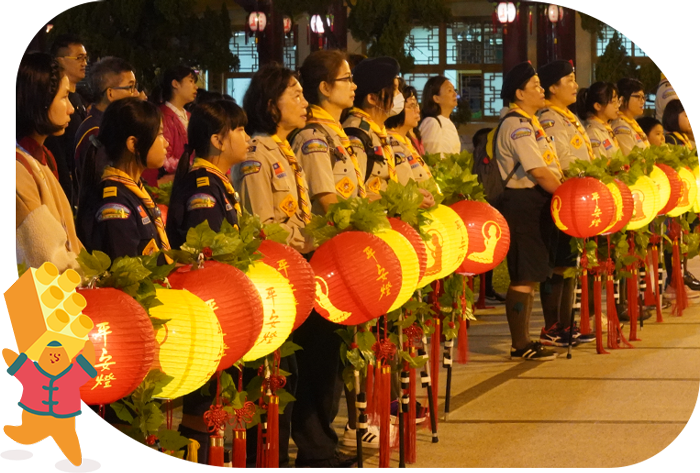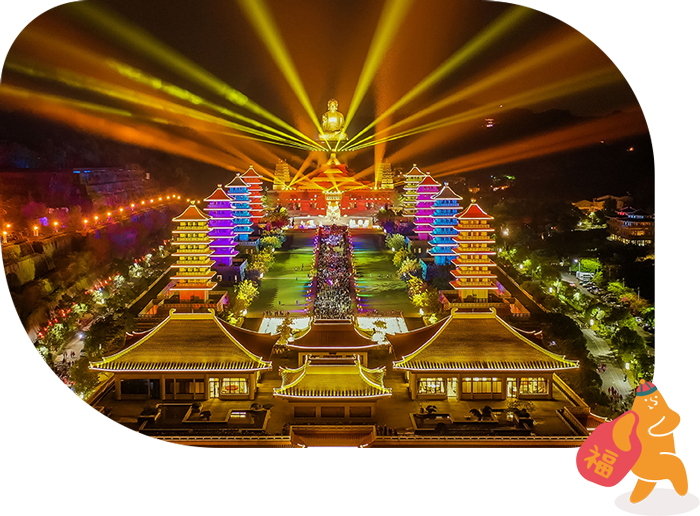2025 Hsi Lai Temple Lunar New Year Celebration Peace Lantern Festival




The light from a single lamp can, in an instant, dispel the darkness that has prevailed for thousands of years. The light symbolizes brightness and wisdom. The Avatamsaka Sutra states, “The light of wisdom can expel all darkness.” A Light Offering is one of the Ten Offerings in Buddhism, and are conducted by Buddhist temples in the form of a Light Offering Dharma Service during the Lunar New Year.
According to the Chinese, lanterns are lit on the 15th day of the Lunar New Year and extinguished on the 18th. Scores are settled on the 19th and journeys are begun on the 20th. In Taiwanese folklore, Temple fairs are also a feature, whereby on the 15th day of the Lunar New Year, Lantern Festivals and Lantern Parades are held.
Each year, the “New Year Festival of Light and Peace” is held at Fo Guang Shan from the 1st to the 30th day of the Lunar New Year, where people can make Light Offerings at the Main Shrine. Furthermore, Light Offerings are made during the Medicine Buddha Dharma Services.
Why do we offer light? Akin to the fire in a stove that cooks food and keeps it warm, the light can dispel darkness and bring people warmth. There is a saying in Fo Guang Shan, “The Buddha’s light shines universally.” The Buddha is the light that makes us brighter, brings us warmth, and offers refuge. With the Buddha’s light in our hearts, we are guided on the path to becoming sages and buddhas, kindling growth and realization.

During the time of the Buddha, there was a bhiksu named Dravya Mallaputra who was entrusted with the task of receiving guests. For 30 years, he would patiently await the arrival of guests no matter how late, and guide them to their lodgings with a lantern in hand to illuminate the path. Several decades later, Dravya Mallaputra no longer needed the lantern to light the way for guests, for his fingers emitted light on their own.
Fascicle Two of the Sutra of Parables chronicles the story of Aniruddha, one of the ten great disciples of the Buddha, known as “foremost in heavenly vision.” In one of his previous lives, Aniruddha was a thief. One day, as this thief snuck into a temple to steal the money donated, he saw that a lamp placed before the Buddha statue was nearly extinguished. Using an arrow, he straightened the wick of the lamp and so the light flared up anew. With the light shining again, he gazed upon the majestic statue of the Buddha and felt ashamed, and vowed to turn over a new leaf. After ninety-one kalpas of cultivation, Aniruddha was able to listen to the Dharma teachings from the Buddha and attain enlightenment. It is said that straightening the wick of the lamp with the arrow became the cause of his encounter with the Buddha, which eventually led to his attainment of arhatship and heavenly vision.
Likewise, Maudgalyayana, foremost in superknowledge, once gave a Dharma talk in Trayastrimsa Heaven. Upon seeing a heavenly maiden, he commended her for her elegant appearance. The heavenly maiden replied that this was the result of light offerings made in her past life during the reign of King Bimbisara.
When making a light offering to the Buddha, it is of greater importance to illuminate the light within. All buddha lands are infinitely bright for there is no darkness within the minds of the buddhas. Making a light offering is not merely an offering, but also sheds light on our right mindfulness and faith.
Have you given rise to faith? To have faith is to affirm our buddha-nature. Without faith, the light within us is unlit. Once our inner light is sparked, we must add oil to fuel it. This applies to many things in this world as well. For example, when the oil in a car is refilled, it can keep moving. In Buddhism, to add oil means to rejoice and practice generosity as well as wholesome and virtuous deeds. Once our faith and merit are fulfilled our inner light will shine clearer and brighter than even sunlight or moonlight, illuminating every corner of the universe. When our inner light is lit, our buddha-nature is revealed, and our mind is filled with brightness and purity. Only then can loving-kindness, compassion, and wisdom arise.
In the time of the Buddha, sages that possessed superknowledge radiated light, for it was their virtuous deeds that earned the respect and reverence of the people. The Buddha and sages radiating light reminds us to emulate them, to practice self-awareness, and strive to shine our inner light so that we may also radiate light throughout our lives. In our daily lives, let our mouths shine by speaking good words; let our eyes shine by acknowledging and treating people with loving-kindness; let our hands shine by doing good deeds. If everyone can shine with the lights of loving-kindness, compassion, and prajna wisdom, not only are we illuminating others, we will also be illuminating ourselves.

